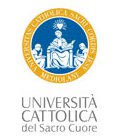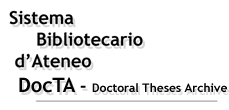|
|
DocTA - Doctoral Theses Archive >
Tesi di dottorato >
SCUOLA DI DOTTORATO IN SISTEMA AGRO-ALIMENTARE >
Citazione:
Utilizza queste indicazioni per citare o creare un link a questo documento.
|
Van Zeller De Macedo Basto Gonçalves, Maria Isabel. "ROLE OF STILBENES AS A RESISTANCE FACTOR OF THE GRAPEVINE TOWARDS BIOTIC STRESS", Università Cattolica del Sacro Cuore, XXII ciclo, a.a. 2008/09, Piacenza, [http://hdl.handle.net/10280/775].
|
| Titolo: | ROLE OF STILBENES AS A RESISTANCE FACTOR OF THE GRAPEVINE TOWARDS BIOTIC STRESS |
| Autore/i: | VAN ZELLER DE MACEDO BASTO GONÇALVES, MARIA ISABEL |
| Tutor: | BAVARESCO, LUIGI
FREGONI, MARIO |
| Coordinatore: | PIVA, GIANFRANCO |
| Lingua: | ENG |
| Abstract in italiano della tesi: | La vite è in grado di attivare meccanismi di difesa in risposta a stress biotici e abiotici producendo principalmente metaboliti secondari tra i quali composti stilbenici. Questi composti, detti anche fitoalessine, hanno una azione benefica e riconosciuta sulla salute umana.
Una delle malattie che apporta più danni in tutto il mondo viticolo è la peronospora, causata dal patogeno Plasmopara viticola L, questa tesi ha lo scopo di confrontare le risposte di diverse varietà e cloni attaccate da questo patogeno. Sono state utilizzate foglie e bacche di 10 cloni di Cabernet Sauvignon per verificare l’andamento dell’infezione e la produzione degli stilbeni nel tempo.
Stessa procedura è stata applicata su foglie giovani e vecchie delle varietà di Müller-Thurgau, Chardonnay, Sangiovese, Pinot noir, Cabernet Sauvignon e Solaris. Queste sono state monitorate per verificare l’andamento dell’infezione, la produzione degli stilbeni e l’attivazione della stilbene sintasi.
I risultati delle prove condotte hanno evidenziato differenze tra le varietà e tra i cloni e, soprattutto, tra i diversi organi studiati. |
| Abstract in inglese: | The grapevine is able to activate a defence mechanism whenever it interacts with biotic or abiotic stress, mainly by producing defence substances as the stilbenic compounds, phytoalexins known for their health related influence. Combining this fact and the knowledge that the Plasmopara viticola Berk et Curtis, the causal agent of downy mildew, causes considerable damages worldwide to Vitis vinifera L. production during its life cycle, this thesis aims to explore the differences that several grapevine varieties and clones display when confronted with this pathogen.
The leaves and small berries of 10 different clones of Cabernet Sauvignon were used to asses infection time course and stilbenic production overtime.
Likewise, young and old leaves of the varieties Müller-Thurgau, Chardonnay, Sangiovese, Pinot noir, Cabernet Sauvignon and Solaris, ordered in assumed increasing resistance, were used to assess infection time course, stilbene production on the leaves and the activation of a stilbene synthase gene.
All trials conducted highlighted not only the differences within grapevine varieties and grapevine clones but most importantly between the studied grapevine organs. |
| Data di discussione: | 22-apr-2010 |
| URI: | http://hdl.handle.net/10280/775 |
| È visualizzato nelle collezioni: | SCUOLA DI DOTTORATO IN SISTEMA AGRO-ALIMENTARE
FACOLTA' DI AGRARIA
|
File in questo documento:
| File |
Descrizione |
Dimensioni | Formato | Accessibilità |
|---|
| testo completo.pdf | testo completo | 4,57 MB | Adobe PDF | Visualizza/apri
|
| cover-abst-index.pdf | frontespizio, indice , abstract | 70,5 kB | Adobe PDF | Visualizza/apri
|
|
Accesso e utilizzo dei contenuti di DocTA
|



